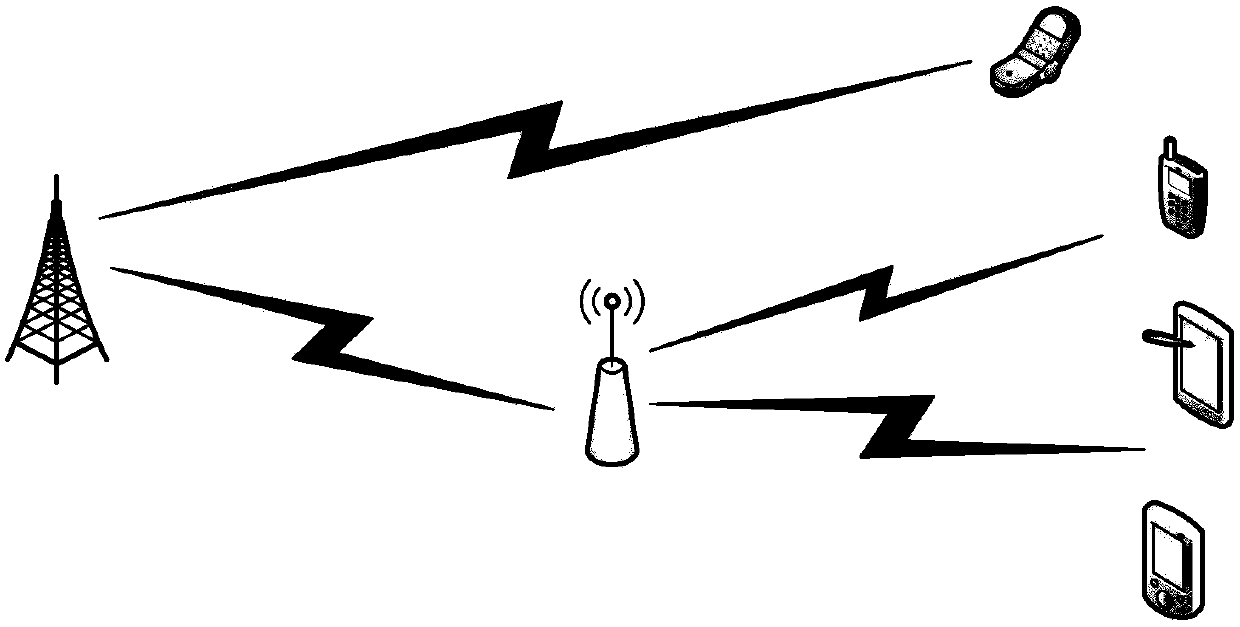Allocating method of united resource of relay system based on optimal energy efficiency
A relay system and resource allocation technology, applied in the field of joint resource allocation of relay systems based on optimal energy efficiency
- Summary
- Abstract
- Description
- Claims
- Application Information
AI Technical Summary
Problems solved by technology
Method used
Image
Examples
Embodiment 1
[0080] A relay system joint resource allocation method based on energy efficiency optimization, including
[0081] Step 1: build system model;
[0082] The present invention is aimed at a special application scene, comes from practical application, and the scene setting is meticulous and reasonable, and has practical guiding significance. Such as figure 1 As shown, the scenario considered in the present invention is a single-relay multi-user OFDM system. There is one relay and K users in the system, and the total bandwidth is equally divided into N subcarriers. Different subcarriers are independent of each other, and the channels of all subcarriers are subject to Rayleigh fading.
[0083] The system transmits signals through two time slots: in the first time slot, the signal source broadcasts the signal, and both the relay and the user accept the signal from the source node; in the second time slot, the relay completes the Carrier pairing, according to the channel state inf...
Embodiment 2
[0123] Observing the optimization problem P1, it can be found that the objective function is a nonlinear mixed integer programming. If the branch and bound method is used to solve this problem directly, there will be great computational complexity. Therefore, this section applies a relatively simple method to solve the objective function, which greatly reduces the computational complexity. Firstly, the problem is simplified so that it can be solved using conventional linear programming methods.
[0124] In order to reduce the complexity of the algorithm for practical application, the present invention proposes a simplified embodiment, specifically, the solution of the optimization problem P1 in the step 3 can adopt a simplified objective function, including:
[0125] The optimization objective function in the optimization problem P1 is a nonlinear programming of mixed integers. In order to reduce the difficulty of solving this problem, the problem is converted into a common li...
Embodiment 3
[0142] The present invention can be further improved on the basis of Embodiment 2, and the objective function of the optimization problem P2 in the step 3 can be further converted into a continuous linear programming, including:
[0143] Generally speaking, the optimal solution obtained by relaxing the constraints is the upper bound of the optimal solution of the original objective function. Later in this paper, it will be explained that the optimization problem P1 and the optimization problem P2 in this section have the same optimal solution. After transforming the optimization problem P1 of the shaping optimization model into the optimization problem P2 of continuous nonlinear programming, the second step is to transform it into continuous linear programming. Define the optimal solution of the optimization problem P2 as q * ,Right now Redefine the function:
[0144] F ( q ) = m a x ( ...
PUM
 Login to View More
Login to View More Abstract
Description
Claims
Application Information
 Login to View More
Login to View More - R&D
- Intellectual Property
- Life Sciences
- Materials
- Tech Scout
- Unparalleled Data Quality
- Higher Quality Content
- 60% Fewer Hallucinations
Browse by: Latest US Patents, China's latest patents, Technical Efficacy Thesaurus, Application Domain, Technology Topic, Popular Technical Reports.
© 2025 PatSnap. All rights reserved.Legal|Privacy policy|Modern Slavery Act Transparency Statement|Sitemap|About US| Contact US: help@patsnap.com



